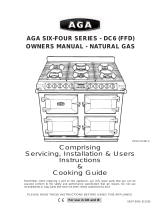
5
General advice
Food should not be placed into any oven until it is up to
normal operating heat.
The oven doors should not be left open for long periods of
time during cooking and heating up.
Store the cold plain shelf outside the cooker. Use it cold in
the roasting oven to deect heat from the top of the oven,
creating a more moderate oven temperature underneath. It
can also be used as a baking sheet.
Warm up times
As the AGA works on the principle of storing heat, time is
required to gather that heat from the electric elements to
saturate the castings. We recommend to allow an hour heat
up time. The optional programmer is a great asset as it can
be set to get the top oven to its working heat, ready for you
to cook when you walk through the door.
The principle of heat storage means that the ovens and
hotplate are at a pre-set heat, the cooking areas are named
after their function rather than temperatures.
Using the zones of the AGA 60
The dierent zones of the AGA 60 cooker are described
individually, in the following pages.
The traditional AGA heat storage cooker is famous for the
gentle warmth it emits, with the AGA 60 you will get warmth
only when the cooker is on or warmth to a lesser degree
when only parts of it are on.
The hotplate
The cast iron hotplate is operated manually and is machined
at to give the best all-over contact with the AGA saucepans,
grill pan, frying pan and kettle.
The boiling plate setting is the hottest with the simmering
plate setting being cooler. It has electric elements embedded
into the cast iron which heat up in approximately 11 and 8
minutes respectively. The hotplate can be used completely
independently from the ovens.
The whole hotplate area can be used for cooking and several
pans can be accommodated on the plate at any one time. The
hotplate is set very slightly above the top plate to minimise
scratching as the pans are pulled to one side to simmer.
The chrome insulated cover is brought down over the
hotplate when it is heating up or not in use. When the
hotplate is ‘ON’ the insulated cover will be warm. We strongly
advise not to put anything such as kettles, saucepans or
baking tins directly onto the insulated cover because it will
show any scratches - invest in a chef’s pad to protect the
surface if the cover is to be used as a resting place!
Keep the hotplate clear of any burnt on food or crumbs
by brushing with the wire brush, supplied with your AGA.
Cleaning details can be found on “Cleaning & caring for
your cooker” on page 18.
Hotplate control
To operate the boiling plate setting turn the control knob to
the position and similarly to the for the simmer plate
setting.
The boiling plate setting
The hottest setting, the boiling plate setting is used for
boiling, grilling, stir-frying, making toast - indeed anything
that requires a high heat. Green vegetables keep their
colour when boiled quickly here, or use a steamer over the
saucepans to cook more than one vegetable at once.
When stir-frying or cooking anything that is inclined to splash
we would recommend using an AGA Splash Shield which will
protect the insulated cover from splatter, making cleaning
a doddle! Just wash the Splash Shield in hot soapy water or
place in a dishwasher between two dinner plates.
Please be advised the boiling plate setting is too hot to cook
food directly on it.
The simmering plate setting
The simmering plate setting is the cooler of the two settings
and so is used for recipes that require a lower heat such as,
making sauces, scrambling eggs, heating milk, slow frying,
simmering soups and root vegetables. In addition, it can
be used to cook on directly as a form of griddle - invaluable
for toasted sandwiches, quesadillas, drop scones, searing
scallops and even a non-fat fried egg! Slow cooked toast can
be made on the simmering plate setting, no need to use the
AGA toaster here.





















